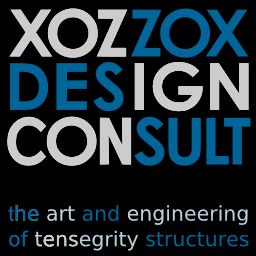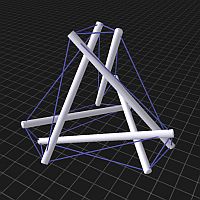Tensegrity structures are objects in which solid struts are linked by cords or cables. The tension of the cords is taken up by the struts which counteract the compressional force exerted by the cords. The structure takes on a shape in which all the forces are balanced. The artist Kenneth Snelson was the first to elaborate the concept since the end of the 1940's. The term Tensegrity was coined by the architect Buckminster Fuller.
Tensegrity concepts and structures have applications in
- architecture (e.g. bridges, domes),
- mechanical engineering (e.g. foldable support structures, actuators),
- biology, pharmaceuticals, and healthcare (e.g. structural stability of cells, prosthetics), and
- art (sculptures).
XOZZOX Design and Consulting Services support you in constructing, optimizing, and building tensegrity structures. This includes structure definition, form finding (taking into account the influence of gravity and realistic modelling of strut-cord joints), custom interactive visualizations, etc.
We create virtual models and physical Tensegrity Objects using a diverse range of materials for struts and cords.
Please contact us at ![]()
Some selected links related to tensegrity:
A good introductory source on tensegrities, including additional links, is the
Wikipedia entry "Tensegrity" .
Visiting Kenneth Snelsons Home Page is a must.
The blog of Landolf Rhode-Barbarigos contains interesting observations, photos, and links mainly related to tensegrities in architecture. The "P.M.S.R-B Bridge" object in my tensegrtiy applet is the object of his Ph.D. thesis.
Another essential resource is Bob Burkhardts online book "A Practical Guide to Tensegrity Design". His "Synergetics Gallery" provides a wealth of examples.
For the more mathematically inclined, the work of Bob Terrel and Bob Conelly of Cornell University, analysing highly symmetric tensegrity stuctures, may be of interest.


